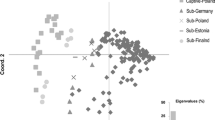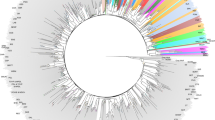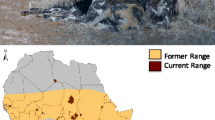Abstract
Background
The raccoon dog (Nyctereutes procyonoides), endemic to East Asia, is classified as six subspecies according to their geographical distribution including a population introduced to Europe. Studies on phylogenetic relationship or population genetics in both native and introduced areas have been carried out recently. Lately, opinions that Japanese raccoon dogs should be classified as a different species were asserted based on several studies using karyotypes, morphometric characters, mtDNA, and microsatellites analysis. However, no data pertaining to the nuclear DNA (nDNA) or Y chromosome are available.
Objective
To estimate the relationship among the species using different genes is necessary in understanding of the history of this species.
Method
Therefore, we investigated nDNA and Y chromosomes in our study to define relationships: (1) between continental raccoon dog populations, (2) between original and introduced groups, and (3) between continental and Japanese groups.
Results
The analysis of four nuclear (CHRNA1, VTN, TRSP, WT1) and ZFY genes indicated that there had been no genetic differentiation among the continental populations. However, significant differences were observed between continental and Japanese raccoon dogs in VTN and ZFY genes implying genetic differentiation has been going between them.
Conclusion
To better understand the phylogenetic relationship among raccoon dog populations, further study will be necessary.



Similar content being viewed by others
References
Akaike H (1974) A new look at the statistical model identification. IEEE Trans Autom Control AC 19:716–723
Ansorge H, Ranyuk M, Kauhala K, Kowalczyk R, Stier N (2009) Raccoon dog, Nyctereutes procyonoides, populations in the area of origin and in colonised regions—the epigenetic variability of an immigrant. Ann Zool Fennici 46:51–62
Bardeleben C, Moore RL, Wayne RK (2005) A molecular phylogeny of the Canidae based on six nuclear loci. Mol Phylogenet Evol 37:815–831
Chan Y-C, Ross C, Inoue-Murayama M, Inoue E, Shih C-C, Vigilant L (2012) A comparative analysis of Y chromosome and mtDNA phylogenies of the Hylobates gibbons. BMC Evol Biol 12:150
Chen Z, Yang G (2014) Identification and characterization of twenty-seven short interspersed elements from three cetaceans. J Genet 94:56–61
Drummond AJ, Rambaut A (2007) BEAST: Bayesian evolutionary analysis by sampling trees. BMC Evol Biol 7:214
Drummond A, Ashton B, Cheung M, Heled J, Kearse M, Moir R, Stones-Havas S, Thierer T, Wilson A (2009) Geneious v4.7.6. In. https://www.geneious.com/. Accessed 3 Mar 2020
D'Souza UM, Russ C, Tahir E, Mill J, McGuffin P, Asherson PJ, Craig IW (2004) Functional effects of a tandem duplication polymorphism in the 5' flanking region of the DRD4 gene. Biol Psychiatry 56:691–697
Ellerman JR, Morrison-Scott TCSS (1966) Checklist of Palaearctic and Indian mammals 1758 to 1946. British Museum, London
Erlandsson R, Wilson JF, Pääbo S (2000) Sex chromosomal transposable element accumulation and male-driven substitutional evolution in humans. Mol Biol Evol 17:804–812
Feng J, Lajia C, Taylor DJ, Webster MS (2001) Genetic distinctiveness of endangered dwarf blue sheep (Pseudois nayaur schaeferi): evidence from mitochondrial control region and Y-linked ZFY intron sequences. J Hered 92:9–15
Fields RL, Gainer H (2015) The -216- to -100-bp Sequence in the 5'-flanking region of the oxytocin gene contains a cell-type specific regulatory element for its selective expression in oxytocin magnocellular neurones. J Neuroendocrinol 27:702–707
Hayashi S, Watanabe J, Kawajiri K (1991) Genetic polymorphisms transcriptional regulation in the 5'-flanking of the human region cytochrome change P45011E1 gene. J Biochem 110:559–565
Heptner VG, Naumov NP, Yurgenson PB, Sludskii AA, Chirkova AF, Bannikov AG (1998) Mammals of the Soviet Union. In: Hoffman R (ed) Sirenia and carnivora Part 1a, 2nd edn. Smithsonian Institute Libraries and the National Science Foundation, Washington, pp 82–123
Hong Y, Kim K-S, Lee H, Min MS (2013) Population genetic study of the raccoon dog (Nyctereutes procyonoides) in South Korea using newly developed 12 microsatellite markers. Genes Genet Syst 88:69–76
Hong Y, Kim K-S, Kimura J, Kauhala K, Voloshina I, Goncharuk MS, Yu L, Zhang YP, Sashika M, Lee H (2018) Genetic diversity and population structure of East Asian raccoon dog (Nyctereutes procyonoides): genetic features in central and peripheral populations. Zool Sci 35:249–259
Jackson JD, Remedios N, Maher KH, Zefania S, Haig S, Oyler-McCance S, Blomqvist D, Burke T, Bruford MW, Székely T, Kűpper C (2017) Polygamy slows down population divergence in shorebirds. Evolution 71:1313–1326
Jeanmougin F, Thompson JD, Gouy M, Higgins DG, Gibson TJ (1998) Multiple sequence alignment with Clustal X. Trends Biochem Sci 23:403–405
Kauhala K, Kowalczyk R (2011) Invasion of the raccoon dog Nyctereutes procyonoides in Europe: history of colonization, features behind its success, and threats to native fauna. Curr Zool 57:584–598
Kauhala K, Saeki M (2004) Raccoon dogs. Oxford University Press, New York
Kauhala K, Viranta S, Kishimoto M, Helle E, Obara I (1998) Skull and tooth morphology of Finnish and Japanese raccoon dogs. Ann Zool Fennici 35:1–16
Kim SI (2011) Craniometric variation and phylogenetic relationship of raccoon dog populations (Nyctereutes procyonoides) in Eurasia. Seoul National University, Korea
Kim SI, Park SK, Lee H, Oshida T, Kimura J, Kim YJ, Nguyen ST, Sashika M, Min MS (2013) Phylogeography of Korean raccoon dogs: implications of peripheral isolation of a forest mammal in East Asia. J Zool 290:225–235
Kim SI, Oshida T, Lee H, Min MS, Kimura J (2015) Evolutionary and biogeographical implications of variation in skull morphology of raccoon dogs (Nyctereutes procyonoides, Mammalia: Carnivora). Biol J Linn Soc 116:856–872
Kirkpatrick M, Hall DW (2004) Male-biased mutation, sex linkage, and the rate of adaptive evolution. Evolution 58:437–440
Kleiman DG (1977) Monogamy in mammals. Q Rev Biol 52:39–69
Koepfli KP, Jenks SM, Eizirik E, Zahirpour T, Van Valkenburgh B, Wayne RK (2006) Molecular systematics of the Hyaenidae: relationships of a relictual lineage resolved by a molecular supermatrix. Mol Phylogenet Evol 38:603–620
Korhonen H, Mononen J, Harri M (1991) Evolutionary comparison of energy economy between Finnish and Japanese raccoon dogs. Comp Biochem Physiol Part A Physiol 100:293–295
Lecocq T, Vereecken NJ, Michez D, Dellicour S, Lhomme P, Valterová I, Rasplus JY, Rasmont P (2013) Patterns of genetic and reproductive traits differentiation in Mainland vs. Corsican populations of bumblebees. PLoS ONE 8:e65642
Librado P, Rozas J (2009) DnaSP v5: a software for comprehensive analysis of DNA polymorphism data. Bioinformatics 25:1451–1452
Miller MA, Pfeiffer W, Schwartz T (2010) Creating the CIPRES science gateway for inference of large phylogenetic trees. In: 2010 Gateway Computing Environments Workshop (GCE), pp 1–8
Nakagome S, Pecon-Slattery J, Masuda R (2008) Unequal rates of Y chromosome gene divergence during speciation of the family Ursidae. Mol Biol Evol 25:1344–1356
Paulauskas A, GriciuvienĖ L, Radzijevskaja J, Gedminas V (2016) Genetic characterization of the raccoon dog (Nyctereutes procyonoides), an alien species in the Baltic region. Turk J Zool 40:933–943
Peakall R, Smouse PE (2012) GenAlEx 6.5: genetic analysis in Excel. Population genetic software for teaching and research-an update. Bioinformatics 28:2537–2539
Pecon Slattery J, Sanner-Wachter L, O'Brien SJ (2000) Novel gene conversion between X-Y homologues located in the nonrecombining region of the Y chromosome in Felidae (Mammalia). Proc Natl Acad Sci USA 97:5307–5312
Perini FA, Russo CA, Schrago CG (2010) The evolution of South American endemic canids: a history of rapid diversification and morphological parallelism. J Evol Biol 23:311–322
Pitra C, Schwarz S, Fickel J (2010) Going west—invasion genetics of the alien raccoon dog Nyctereutes procynoides in Europe. Eur J Wildl Res 56:117–129
Posada D (2008) jModelTest: phylogenetic model averaging. Mol Biol Evol 25:1253–1256
Rambaut A, Drummond A (2009) FigTree v1. 3.1. https://tree.bio.ed.ac.uk/. Accessed 3 Mar 2020
Rokas A, Holland PWH (2000) Rare genomic changes as a tool for phylogenetics. Trends Ecol Evol 15:454–459
Ronquist F, Teslenko M, van der Mark P, Ayres DL, Darling A, Höhna S, Larget B, Liu L, Suchard MA, Huelsenbeck JP (2012) MrBayes 3.2: efficient Bayesian phylogenetic inference and model choice across a large model space. Syst Biol 61:539–542
Schvartz I, Seger D, Shaltiel S (1999) Vitronectin. Int J Biochem Cell Biol 31:539–544
Shedlock AM, Okada N (2000) SINE insertions: powerful tools for molecular systematics. BioEssays 22:148–160
Singh B, Su YC, Riesbeck K (2010) Vitronectin in bacterial pathogenesis: a host protein used in complement escape and cellular invasion. Mol Microbiol 78:545–560
Song N, Li H, Cai W, Yan F, Wang J, Song F (2016) Phylogenetic relationships of Hemiptera inferred from mitochondrial and nuclear genes. Mitochondrial DNA A DNA Mapp Seq Anal 27:4380–4389
Stephens M, Smith NJ, Donnelly P (2001) A new statistical method for haplotype reconstruction from population data. Am J Hum Genet 68:978–989
Sutor A, Schwarz S, Conraths FJ (2014) The biological potential of the raccoon dog (Nyctereutes procyonoides Gray 1834) as an invasive species in Europe—new risks for disease spread? Acta Theriol 59:49–59
Tamura K, Stecher G, Peterson D, Filipski A, Kumar S (2013) MEGA6: molecular evolutionary genetics analysis version 6.0. Mol Biol Evol 30:2725–2729
Trujillo RG, Schlitter DA, Bickham JW (2009) Molecular phylogenetics of the bat genus scotophilus (Chiroptera: Vespertilionidae): perspectives from paternally and maternally inherited genomes. J Mammal 90:548–560
Tsubouchi A, Fukui D, Ueda M, Tada K, Toyoshima S, Takami K, Tsujimoto T, Uraguchi K, Raichev E, Kaneko Y, Tsunoda H (2012) Comparative molecular phylogeny and evolution of sex chromosome DNA sequences in the family Canidae (Mammalia: Carnivora). Zool Sci 29:151–161
Venta PJ, Brouillette JA, Yuzbasiyan-Gurkan V, Brewer GJ (1996) Gene-specific universal mammalian sequence-tagged sites: application to the canine genome. Biochem Genet 34:321–341
Wada MY, Imai HT (1991) On the Robertsonian polymorphism found in the Japanese raccoon dog (Nyctereutes procyonoides viverrinus). Jpn J Genet 66:1–11
Wada MY, Lim Y, Wurster-Hill DH (1991) Banded karyotype of a wild-caught male Korean raccoon dog, Nyctereutes procyonoides koreensis. Genome 34:302–306
Wahlberg N, Weingartner E, Warren AD, Nylin S (2009) Timing major conflict between mitochondrial and nuclear genes in species relationships of Polygonia butterflies (Nymphalidae: Nymphalini). BMC Evol Biol 9:92
Wang JY, Frasier TR, Yang SC, White BN (2008) Detecting recent speciation events: the case of the finless porpoise (genus Neophocaena). Heredity (Edinb) 101:145–155
Won BH, Yun MH, Han SH, Kim KJ, Park JK (2004) The mammals of Korea. Dongbang Media, Seoul (in Korean)
Acknowledgements
This work was supported by Korea Research Foundation Grant (KRF-2009-0085754) funded by the Korean Government (MESET) and partially supported by the Research Institute for Veterinary Science, Seoul National University. We are grateful to everyone who donated raccoon dog DNA samples to the Conservation Genome Resource Bank for Korean Wildlife: Junpei Kimura, Kaarina Kauhala, Inna Vsouoloshina, Li-Yu, Ya-ping Zhang, Mariko Sashika, and Truong Son Nguyen.
Author information
Authors and Affiliations
Contributions
YJH designed the experiments, carried out the molecular experiments, data analysis and wrote the manuscript. HL discussed the results, helped to draft the manuscript, and advised for discussion. KSK and MSM conceived of the study, discussed the results and reviewed the manuscript. All authors approved the final manuscript.
Corresponding author
Ethics declarations
Conflict of interest
The authors declare that they have no conflict of interests.
Ethical approval
Not applicable.
Informed consent
Not applicable.
Additional information
Publisher's Note
Springer Nature remains neutral with regard to jurisdictional claims in published maps and institutional affiliations.
Electronic supplementary material
Below is the link to the electronic supplementary material.
Rights and permissions
About this article
Cite this article
Hong, Y., Lee, H., Kim, K.S. et al. Phylogenetic relationships between different raccoon dog (Nyctereutes procyonoides) populations based on four nuclear and Y genes. Genes Genom 42, 1075–1085 (2020). https://doi.org/10.1007/s13258-020-00972-2
Received:
Accepted:
Published:
Issue Date:
DOI: https://doi.org/10.1007/s13258-020-00972-2




